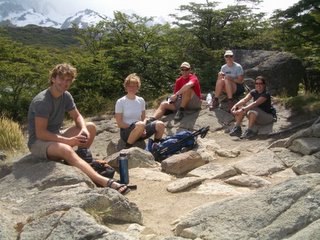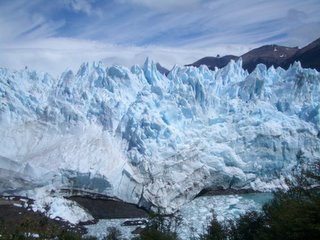

I left Bariloche and headed for El Chalten on the famous Ruta 40, which is the main road on the Argentine side of Patagonia. The only way to take this route is with a small group, and it consists of driving for about 15 hours each day for two days, with a stop one night at a hostel in the middle of nowhere. We also stopped at the Cueva de las Manos (Cave of the Hands) on the second day to break things up a bit. This route gives a great feel for the magnitude and desolation of Patagonia....miles and miles of dusty, windy, lonely nothingness. We saw road runners (called Ñandu) and guanacos along the way. Much of it consisted of flat plains but as we got closer to El Chalten there were more mountains, lakes, and rivers. The long trip provided a lot of opportunity for conversation with the other travelers, and the bumpy, gravel roads insured that little sleep was to be had. I met some great people, a few of which I ended up traveling with for a while.
The Cave of Hands is prehistoric rock art from 13,000 to 9,500 years ago and consists of outlines of human hands and pictures of animals. It was interesting enough, but I think all of us enjoyed the walking more than anything else after so many hours of driving. And we were all trying to figure out how what seemed to be a thin layer of color could withstand thousands of years of erosion. I'm sure that there is a logical explanation, but the information was in Spanish, and none of us could understand enough of it to figure it out. So, we concluded that some entrepreneurial Argentine must have decided to paint some pictures on rocks and convince naive tourists to pay him $5 to visit them.
We arrived in El Chalten after two days of driving. El Chalten is a village in National Park Los Glaciares and sits at the foot of Mts. Fitz Roy and Cerro Torre -famous for it's mountaineering and trekking - and on the shores of Lake Viedma. It is the transition area between the Patagonian steppe and the Subantartic forest. El Chalten is very small and appears to exist solely to support climbers and trekkers. There was basically one main gravel road and a few side roads with hostels, restaurants and stores for camping gear. Internet was expensive and SLOW, which is part of the reason for my delinquency in updating my blog. Our hostel had a great atmosphere and was hopping with backpackers doing day-hikes, or preparing for longer excursions. One of the guys I met on the Ruta 40 tour is a big climber and while a group of us were eating pizza, pointed out that two world-famous climbers were sitting behind us. Apparently they were attempting a climb that hadn't been done before, and it's supposedly one of the most difficult climbs in the world - not for it's height but for it's degree of technicality.
The views in El Chalten were spectacular. I am beginning to feel like I sound like a broken record with how many times I have repeated that statement, but the beauty of this continent continues to shock me. Each new place is awe-inspiring in a different way than the last, so there's little risk for becoming blasé. The name of the town "El Chalten" means mountain that sends out smoke, and it was named that because it was initially believed it to be a volcano because the mountain's summit was always covered with a layer of clouds. The first day a group of us went of a easy hike for a couple of hours after checking out the town and buying supplies for a longer overnight trip that we had planned to start the following day. We came across another of people camping and trying to stay somewhat sheltered from the relentless winds. The atmosphere was almost bewitching in some areas with all the dead, hollowed out trees. We stopped for a snack by a crystal clear, turquoise lake and enjoyed the views of the vertical cliffs and glaciers in the distance.
We had planned on starting out early the next morning for a 3-4 day trek, but the unpredictable, Patagonian weather reared it's ugly head in the middle of the night. The winds were so strong that it was basically pouring side-ways. The rain let up a little by morning, but the cold, strong winds put a halt on our trekking excursion. The one benefit of the crazy winds is that the weather moves through relatively quickly, and as a result, it improved enough in the afternoon to venture out for another day hike. It was overcast and still very windy, but we could still see the mountains percolating through the clouds. Most of the group turned back after an hour or two, but a girl from Germany and I decided to go farther. We were able to get pretty close to the incredible blue-tinted glaciers of the ice field layered on top of the mountains. Earlier in the day I had decided not to stay in El Chalten and risk that we would again have bad weather the following day, and I was glad that I at least got some good day hikes in. But having a taste of the incredible scenery made it difficult to leave. Most of us left that night on a bus to El Calafate to visit the famous Perito Moreno Glacier.









